The Australian agriculture industry accounts for 58% of the land use throughout states and territories. Agriculture is one of Australia’s great success stories, with a long-term contribution to the Gross Domestic Product (GDP), employment, export and wellbeing of the rural population. In 2018-2019, the agricultural sector employed 2.6% of the Australian workforce and contributed 2.2% of the value-added to the GDP. The horticulture sub-sector accounted for 44% of agriculture contribution to the GDP, while the livestock sub-industry contributed 48% in 2018-2019.
The Australian agriculture industry exports around 70% of agriculture output overseas, demonstrating a high proportion compared to other countries.
For instance, 98% of wool and cotton, 71% of wheat, 76% of beef, 41% of dairy, and 18% of horticultural products were exported between 2013-2017. Australia’s agricultural industry has a stable market as the global agricultural demand is growing, reflecting rising per capita incomes and population growth. However, export competition is also increasing. To sustain this, the industry has to stay current in terms of technological innovations and develop its workforce to keep up with the accelerating agritech changes and competition on the global market.
Agriculture is closely connected with the rest of the economy and lays a strong foundation for growth in the other industries. This means a sustained development in the agriculture sector presents an ideal pathway to increase production and productivity in the remaining sectors of the economy.
Department of Agriculture, Water and the Environment, 2020
Agriculture Industry in the NT
Agriculture remains an integral part of the Northern Territory’s economy. The sector is highly dependent on a well-qualified, reliable, skilled, and experienced workforce. For the past decade (2009-2019), the agriculture industry in the Territory has contributed an average of 2.9% to the Gross State Product (GSP) and has provided direct employment to 1.6% of the NT’s total workforce.
While the industry continuously plays a significant role in the NT’s economy, ongoing changes such as farm consolidation, innovation, and technology adoption have affected the skills and training needs of the workforce. These changes have increased the demand for a skilled workforce with advanced managerial and digital skills to cope with the fast-moving and complex environment surrounded by new risks.
Higher demand for agricultural products both locally and internationally has also spiked the use of seasonal workers. However, increased youth migration from regional areas to urban centres, ageing agriculture workforce and technological acceleration in the NT have exacerbated recruitment challenges, retention difficulties, workforce and skill shortages. These difficulties often force the industry to rely on contract and seasonal workers, which are more financially straining on businesses. This also leaves less room for workers with minimal experience to gain industry-specific skills and experience. The trend of using contractual workers may leave long-term effects on the industry’s ability to gather sufficient experienced workers in the future. Currently, available job opportunities in the NT outstrip the workforce supply, and projections show severe workforce challenges in the future, especially if the current workforce development obstacles are not addressed.
Besides the previously mentioned points, little attention has been given to the documentation of NT specific workforce data, and in cases where the data exists, it is often merged with other Australian states. This Insight presents an overview of the agriculture industry and highlights significant workforce challenges across the Northern Territory. The agriculture industry, for the purpose of this Insight, includes horticulture, mixed farming, and livestock sub-sectors. It excludes aquaculture and forestry.
Agriculture Production in the Northern Territory
The Northern Territory is a significant producer of various agriculture products including horticulture and livestock. The rearing of animals and the growing of crops covers approximately 41% of the total land area of the NT. While commercial production of crops and livestock occur across the Territory’s regions, variations exist in terms of the agriculture products farmed and the production outputs in the different NT regions. The major agriculture products produced include buffalo, cattle, crocodile, mango, melon, citrus, grape, tropical fruit, broadacre crops, vegetables, and herbs. The NT’s agriculture industry has enormous potential to expand and increase productivity when, for example, an adequate workforce equipped with relevant training and skills becomes available.
Size of the Industry
The size of the agriculture industry in the NT is relatively smaller compared to other Australian states in terms of workforce size, with the exception of Australia Capital Territory. The NT’s sector accounts for less than 1% of the number of agricultural businesses in Australia. Agricultural businesses in the Territory are mainly small and medium-sized enterprises, mostly concentrated in the remote and very remote regions of Darwin and Katherine. The industry also comprises of 66% of non-employing businesses (family-owned businesses). Nevertheless, the industry contributed 1.3% of Australia’s agricultural total value of commodities in 2018/2019, demonstrating the Territory’s great potential.
MAP OF THE MAJOR AGRICULTURE PRODUCTION AREAS
Source: Northern Territory Government, Department of Treasury and Finance, Department of Primary Industry and Fisheries 2020
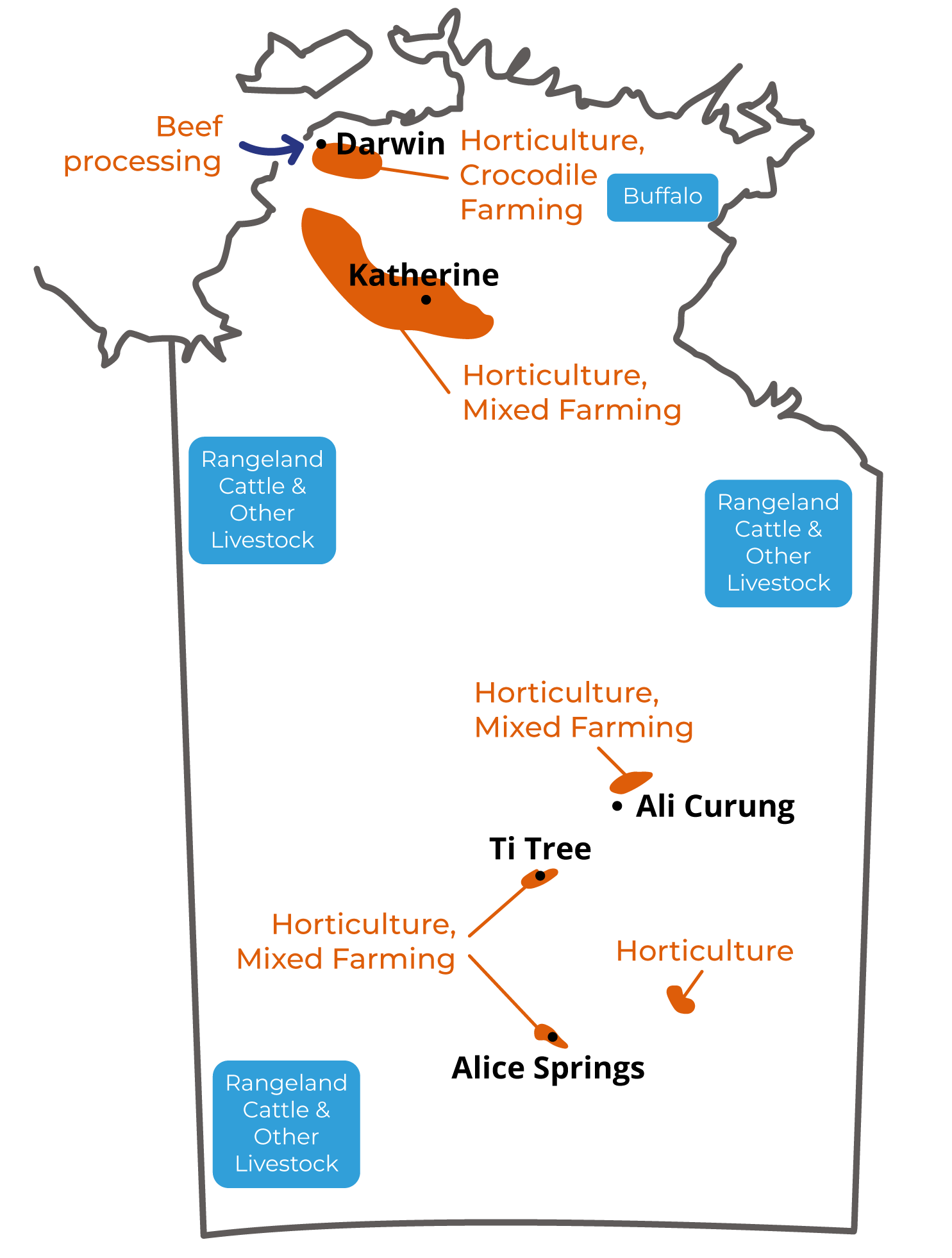
SIZE OF SUB-SECTORS
Source: NT data from ABS, Counts of Australian Businesses, including Entries and Exits, Cat No. 8165.0, June 2015 to June 2020
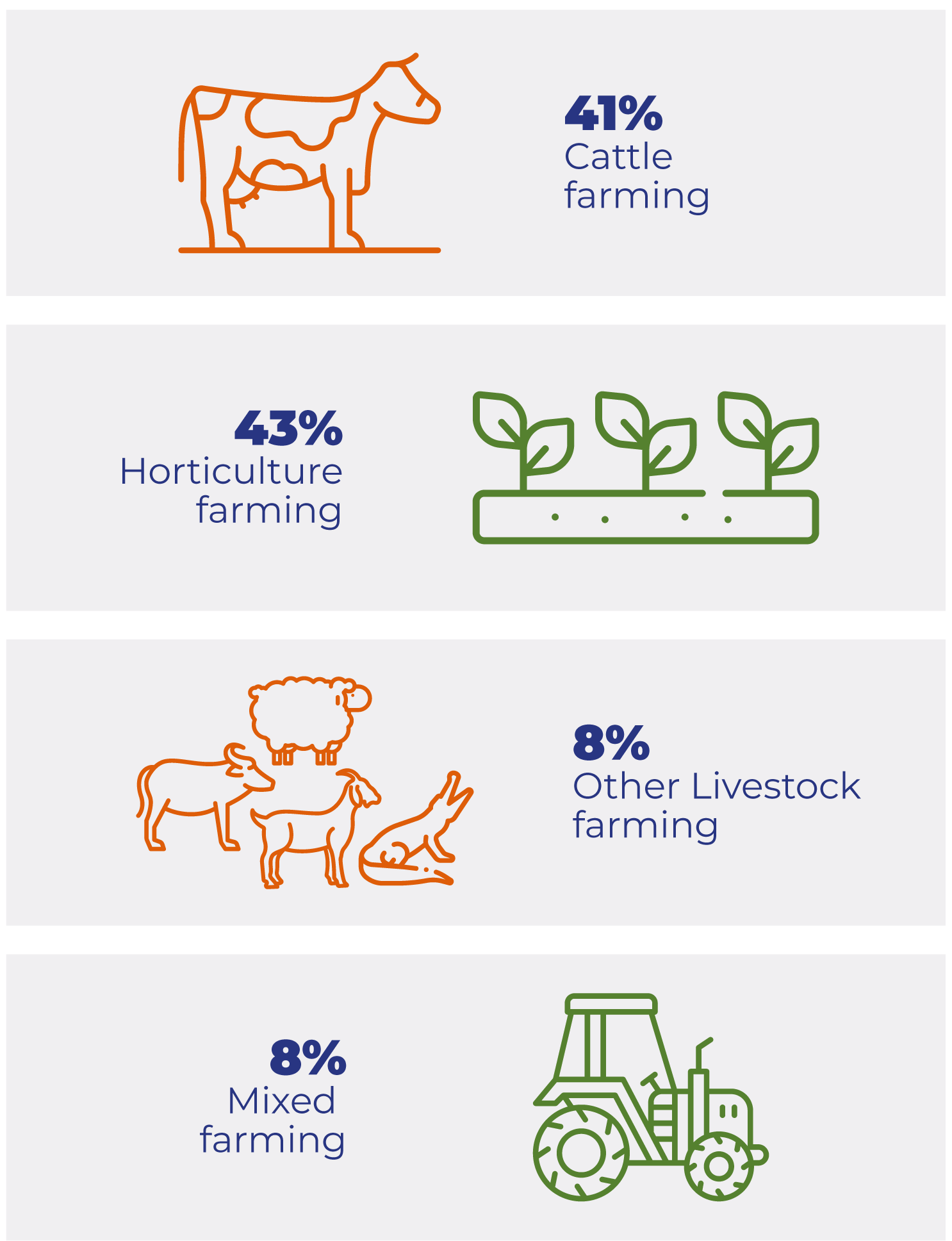
SIZE OF BUSINESSES BY EMPLOYMENT
Source: NT data from ABS, Counts of Australian Businesses, including Entries and Exits, Cat No. 8165.0, June 2015 to June 2020
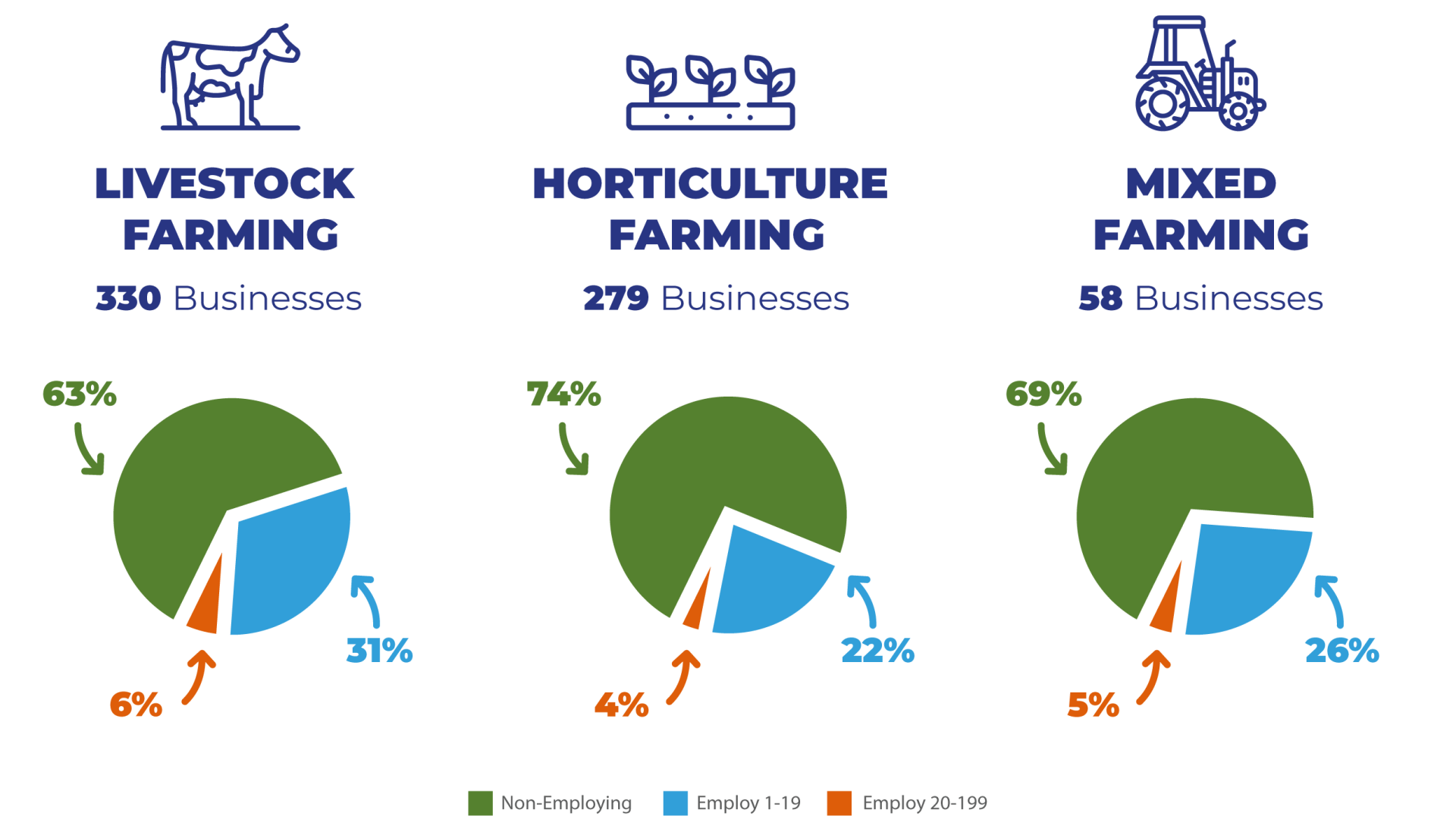
The NT’s agriculture industry has a high proportion of businesses operating for more than 31 years, with most businesses reporting an annual turnover under 2 million dollars. The cattle sub-sector is the highest contributor to agriculture production value in the NT. The agriculture industry’s value-added to the Gross State Product (GSP) has experienced a decline due to the decrease in production values of major products such as live cattle, cereal crops, hay/fodder and mango. The fall in the agriculture sector’s contribution to the NT’s economy may be attributed to farmers’ growing struggle against pests and diseases since 2014. The following captures the agriculture business’ size by employment, turnover, the trends in gross state product and production value in the NT.
INDUSTRY'S SIZE BY ANNUAL TURNOVER
Source: NT data from ABS, Counts of Australian Businesses, including Entries and Exits, Cat No. 8165.0, June 2015 to June 2019

VALUE-ADDED TO GSP
Source: National Institute of Economic and Industry Research (NIEIR), 2019
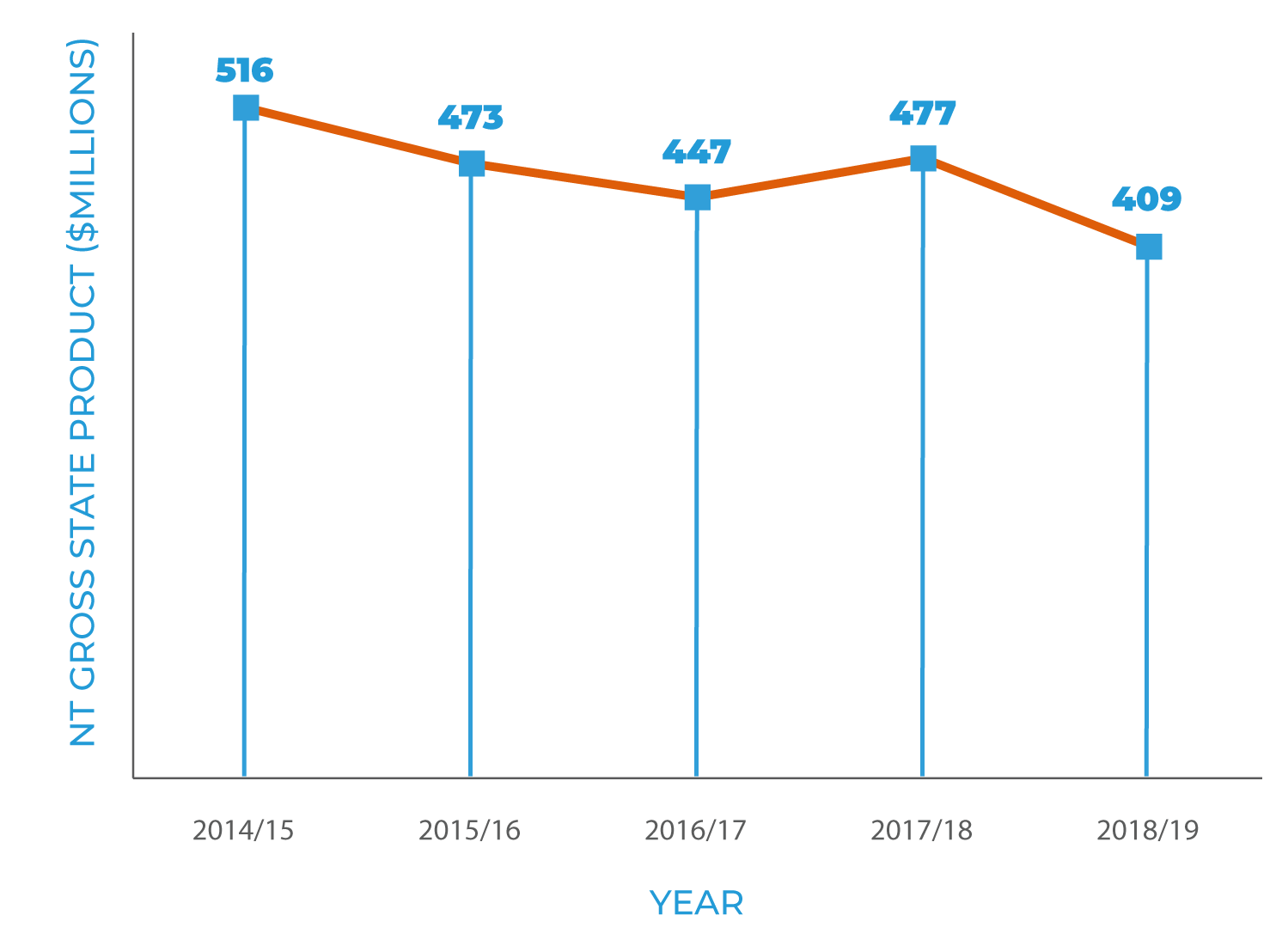
NT PRODUCTION (2018 - 2019)
Source: Department of Primary Industry and Resources, 2019
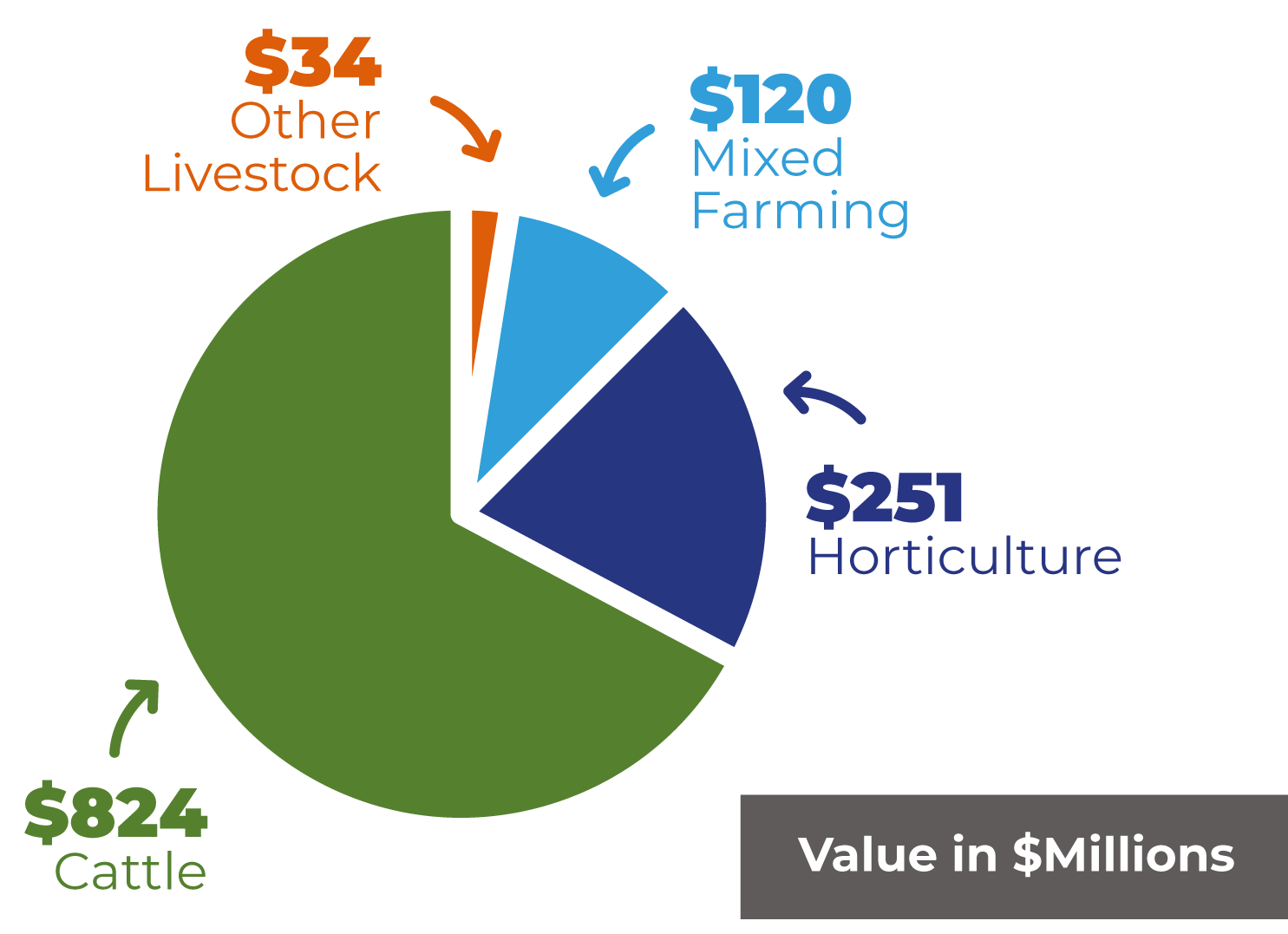
LENGTH OF BUSINESS OPERATIONS
Source: ISACNT Field Survey, 2020

Agriculture is a major contributor to the Northern Territory's economy and crucial to its rural population's wellbeing. The industry in the NT has enormous potential to increase its economic importance in terms of production, productivity, employment, investment and export revenue.
Northern Territory Plant Industries Workforce Development Plan 2020-2025
Industry Intelligence
It is challenging to obtain workforce specific information for the Northern Territory's (NT) agriculture industry. This is because the NT is often excluded from or merged with other states in national workforce studies. This issue coupled with rising workforce challenges such as workforce shortages, attraction and retention problems across the agriculture industry provided the basis for Industry Skills Advisory Council Northern Territory (ISACNT) to undertake an in-depth study of the industry. ISACNT initiated contact with 197 stakeholders in the NT's agriculture industry over the phone. Of the 197 stakeholders, 140 stakeholders were successfully contacted and invited to participate in the workforce study. ISACNT conducted 61 in-depth interviews with NT industry stakeholders and had 2 interviews with interstate stakeholders operating in the NT. Furthermore, ISACNT had in-depth engagements with 2 NT industry peak bodies. The stakeholder response rate from the study was approximately 45%.
Regional response rates
- Darwin and East Arnhem region 41%
- Katherine region 43%
- Barkly region 43%
- Alice Springs region 55%
Socio-demographic Characteristics
The agriculture sector in the Northern Territory like elsewhere in Australia is rapidly changing in terms of workforce characteristics, training needs and skill requirements. The industry has some unique features in comparison to other sectors. For example, the industry has a lower number of post-school qualification holders, an ageing workforce, relatively low employee wages and a high proportion of casual/seasonal workers. The industry is also male-dominated and relies on skilled migrants to sustain the growth of the sector. The sector is characterised by the high proportion of non-employing businesses (family-owned), seasonal work, and its physically demanding nature. However, the Territory’s agriculture industry also has excellent opportunities for workers willing to build and enhance skills and experience across different environmental, climatic conditions, and farm/station sizes.
EMPLOYMENT TRENDS
Source: National Institute of Economic and Industry Research (NIEIR), 2019
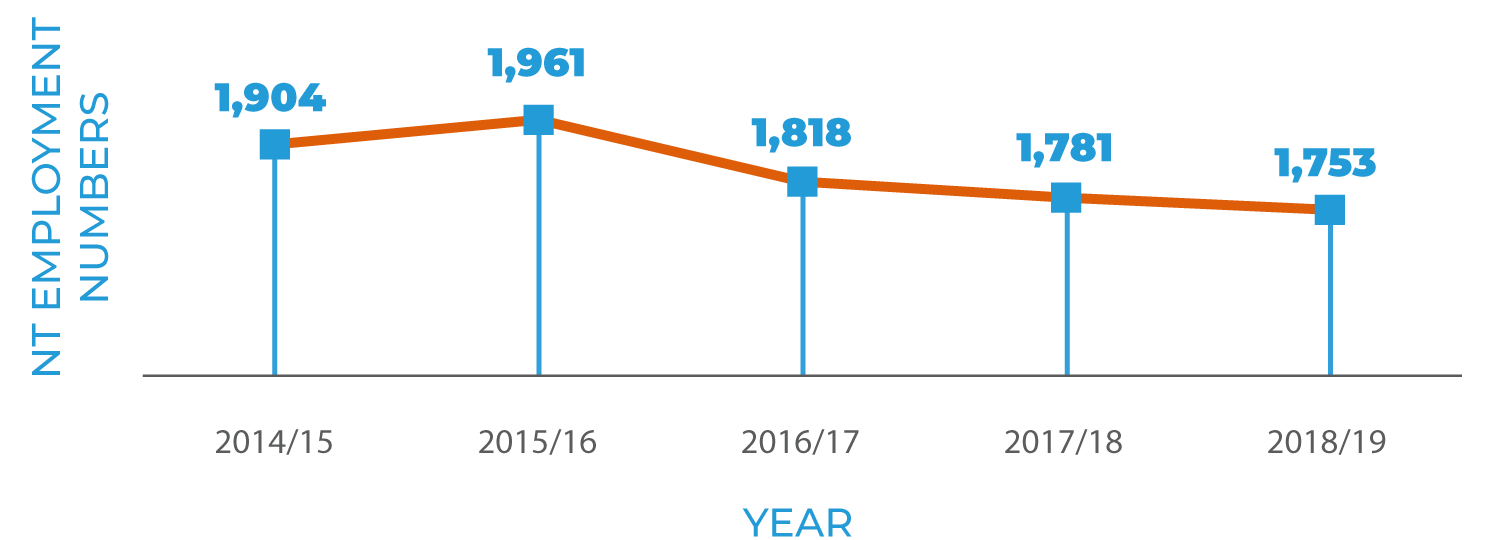
AVERAGE EXPERIENCE OF FARM OWNERS
Source: Australian Bureau of Statistics, Agricultural Commodities, Australia 2018-19

APPRENTICESHIP COMPLETION RATE IN 2018-2019
Source: National Centre for Vocational Education Research, 2018-2019.
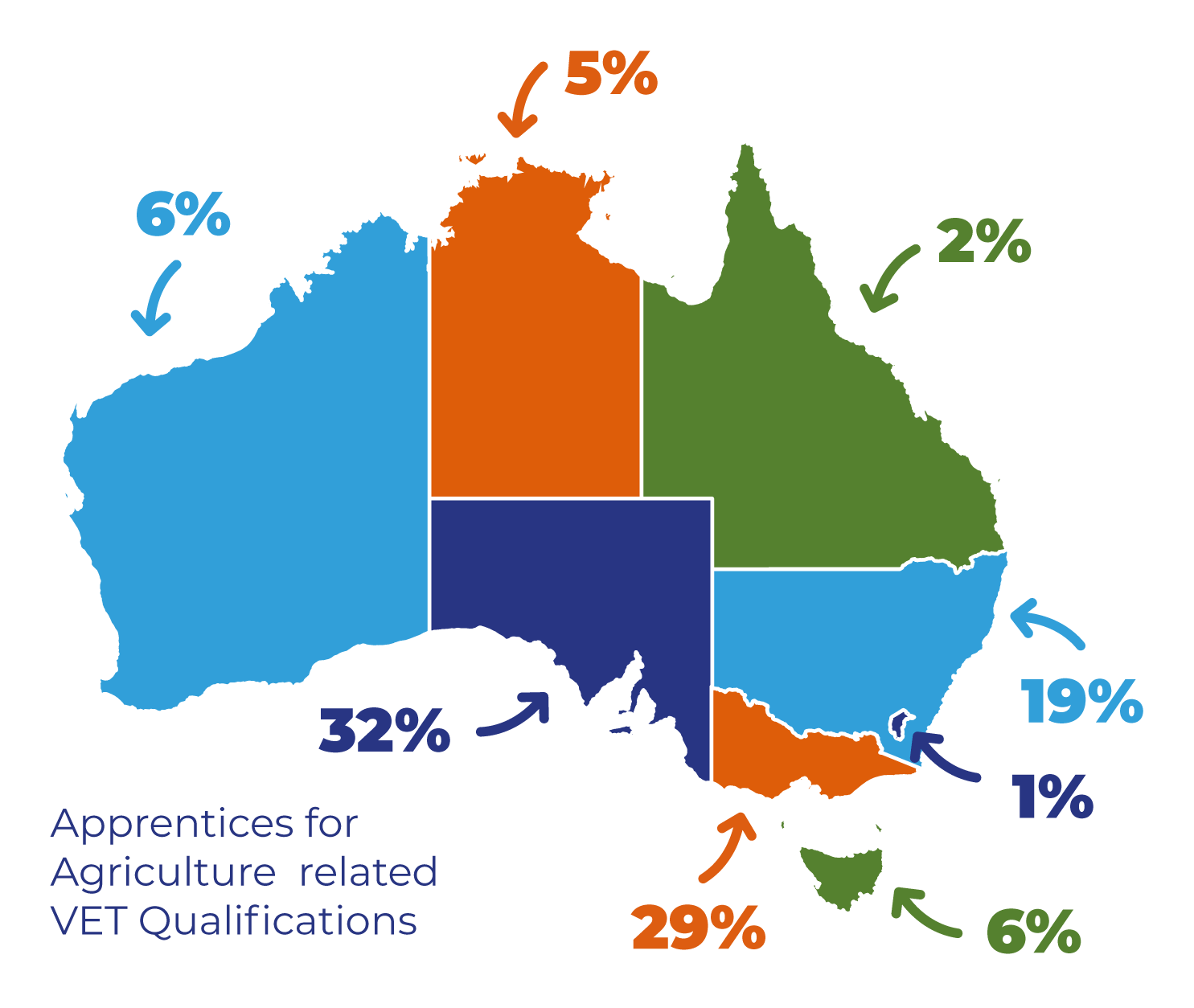
AVERAGE AGE OF FARM OWNERS
Source: Australian Bureau of Statistics, Agricultural Commodities, Australia 2018-19

AGE OF THE WORKFORCE
Source: ISACNT Field Survey, 2020

WORKFORCE RESIDENCY STATUS
Source: ISACNT Field Survey, 2020

BASIS OF EMPLOYMENT
Source: ISACNT Field Survey, 2020 and Australian Bureau of Agricultural and Resource Economics and Sciences (ABARES), 2018

GENDER DISTRIBUTION IN THE NT AND AUSTRALIA
Source: ISACNT Field Survey, 2020 and Australian Bureau of Agricultural and Resource Economics and Sciences (ABARES), 2018

INDIGENOUS STATUS OF THE WORKFORCE
Source: ISACNT Field Survey, 2020 and Australian Bureau of Agricultural and Resource Economics and Sciences (ABARES), 2018

QUALIFICATIONS OF THE WORKFORCE

XPERIENCE OF THE WORKFORCE
Source: ISACNT Field Survey, 2020

RECRUITMENT METHODS
Source: ISACNT Field Survey, 2020 and Australian Bureau of Agricultural and Resource Economics and Sciences (ABARES), 2018

Agricultural development is one of the most powerful tools to end extreme poverty, boost shared prosperity and feed a projected 9.7 billion people by 2050. Growth in the agriculture sector is two to four times more effective in raising incomes among the poorest compared to other sectors.
The World Bank, 2020
Successful Industry Workforce Strategies
Horticulture businesses often experience difficulties attracting seasonal workers, especially during the harvest season. ISACNT’s stakeholder engagement uncovered a few horticulture businesses working around this issue by growing a mixture of crops with varying maturity periods at different times of the year. This ensured the farms were able to retain a large skeleton crew all year-round. The approach made sure the agricultural businesses kept experienced staff for many years. As a result, agricultural businesses utilising this workforce initiative has significantly reduced staff turnovers, recruitment and retention difficulties.

Cattle businesses in the NT also experience difficulties attracting experienced workers every year during mustering season. ISACNT’s stakeholder engagement, likewise, discovered that few businesses were adapting flexible workforce strategies to manage this regular problem. Some businesses have adopted a mixed farming approach producing crops during low seasons for farm use only. Other farms utilised non-agricultural related skills, such as workers with trade skills to assist in property maintenance during low periods. Both approaches ensured a manageable workload for a much larger skeleton crew all year-round, which meant the experienced staff stayed for multiple years at the same location. On the other hand, other cattle businesses kept a minimal skeleton crew year-round and then utilised contract mustering teams to assist during the peak season. Many businesses felt this approach was more financially viable and safer, as contract mustering teams are experienced and exhibit high-quality skills to undertake station activities.
WORKFORCE CHALLENGES
Source: ISACNT Field Survey, 2020

WORKFORCE INITIATIVES UTILISED
Source: ISACNT Field Survey, 2020

Darwin and its Outback region's significant recruitment and retention challenges require a more comprehensive approach that considers all experiences and views of relevant stakeholders' including government institutions, peak bodies, and agricultural businesses
ISACNT Agriculture Stakeholder Engagement Survey, 2020
Occupations in Demand
The agriculture sector plays a vital role in the development of the Northern Territory’s economy in terms of food production, employment, and gross state product. Improving and sustaining the sector’s contribution requires an experienced, qualified, skilled, and reliable workforce. However, findings from ISACNT’s engagement with agriculture stakeholders demonstrated acute workforce shortages, recruitment, and retention difficulties across all regions. During the peak season, such as harvesting for horticulture and mustering for the cattle sub-sectors, these issues were more pronounced.
ISACNT’s findings showed that agriculture businesses often encounter difficulties attracting and retaining experienced workers. This is because experienced staff members often come with family members, compelling the farm/station to accommodate multiple people, which can present challenges for many employers. This issue often results in businesses being unable to hire experienced staff as they cannot accommodate larger family units, affecting business productivity.
Some stakeholders ISACNT engaged with indicated intensified workforce challenges in the future because of the rising demand for agriculture products, technological advancement, and upcoming major agriculture project investments (e.g., Western Davenport Development Project, Wildman Agriculture Precinct, Larrimah Agriculture Precinct, and Keep Plains Agriculture Development). In addition, unforeseen circumstances such as droughts, pandemic outbreaks and the associated impacts, may also exacerbate agricultural workforce challenges and impede the sector’s development.
Based on the results of ISACNT’s stakeholder engagements, the following occupations were found to be in demand:
- Farm Worker
- Farmer
- Agricultural technician
- Agricultural scientist
- Agricultural and Horticultural Mobile Plant Operator
- Governess (Early Childhood educator/teacher)
- Cook
- Boilermaker/Metal Fabricator
- Diesel Mechanic
- Accountant
- Truck driver
- Electrician
WORKFORCE SUPPLY
Source: ISACNT Field Survey, 2020

Non-traditional Industry Roles
The agriculture sector employs industry-relevant occupations such as farm workers, agriculture scientists, agronomists and agricultural and horticultural mobile plant operators. Besides these occupations, the sector also employs other equally important non-agricultural related occupations such as cooks, mechanics and accountants. Another essential occupation, but with limited public recognition, is the governesses job role.
The governess is employed to provide care and educate children of agricultural workers in private homes. Their role is similar to educators or teachers in childcare centres and primary schools. The governess accesses the school of the air and uses the curriculum to teach children on remote stations/farms. The governess most often teaches children at their home until they commence middle school, where they have to attend boarding school.
The job requirements for governesses in Australia includes having a working with children check, also known as Ochre Card in the Northern Territory and a first-aid certificate. There are currently no formal qualifications required to be a governess. However, a Certificate III in Early Childhood Education and Care is highly desirable and recommended to ensure quality education is delivered to children in remote parts of the country.
Australia's climate is changing, and its impacts are evidenced in the differences we are experiencing in rainfall, temperature and extreme weather events. Climate change if not critically looked at may affect agriculture production and increase farm losses.
Department of Agriculture, Water and the Environment, 2020
Major issues Impacting the Industry
The major issues impacting the agriculture industry have direct effects on the workforce development. To improve the workforce development, farmers and peak bodies in consensus, indicated that this is crucial for the sector’s growth. A reliable and experienced workforce equipped with the right skills that reflect both the agriculture industry’s current and future needs is required. Specific training equipping the workforce to manage the industry’s major issues better will ensure a more resilient industry. ISACNT’s engagement with stakeholders within the agriculture industry showed that the sector has enormous potential to increase its export and value-added to the Gross State Product (GSP) in the future. This is because there is potential arable land space within the Territory which have yet to be developed for agricultural use. The findings unravelled four critical factors that are currently impeding agricultural production and workforce development.
- Natural Hazards and Disasters: ISACNT’s engagement with stakeholders in the Northern Territory revealed that natural disasters, such as droughts, cyclones, floods, bushfires, and pests, destroy agricultural assets and infrastructure. Natural disasters further cause livestock and crop production losses. Disasters were also found to disrupt the food retail and manufacturing supply chain. The long-term effect of disasters may cause disruption in employment in the sector, forcing the skilled workforce to migrate to the urban areas in search of opportunities or look for jobs in other competitive industries.
- Water Insecurity: The issue of water insecurity in the Territory is affected by scarce resources. The process of applying for water licenses is often highly bureaucratic, which can negatively impact the growth and development of the agriculture sector and its workforce. The lengthy process of applying for a water permit with the long-term water prediction needed to secure a license, makes it challenging for businesses to accommodate future changes due to commodity price drops or severe pest infections on crops or animals. Climate change and droughts have further depleted the volume of water resources available in the NT, making the water licenses less secure and harder for farmers to receive the required water needed. Water insecurity creates enormous burdens on agricultural businesses, as it forces farms to limit their outputs or quality produced. Furthermore, it takes financial resources away from investing in workforce development, which may negatively impact the industry’s ability to adapt to the changing environment in the long-term perspective.
- Technological Advancement and Acceleration: Interviews with stakeholders revealed a wide use of technology across the agriculture industry even though variations exist in the level and intensity in their adoption across the sub-sectors. Technological adoption in the industry has relatively improved workforce shortages in the sector. For example, the required number of workers needed has been reduced through automation activities, making it easier for employers to obtain the required workforce. Nevertheless, it was found that the innovation of technology in the agriculture sector has also created new job roles, which require additional skill sets that will be difficult accessing in the NT. The data analysis of ISACNT’s stakeholder engagement showed that the reviews of Vocational Education and Training (VET) courses in agriculture often are slow and, therefore, does not commensurate with the rate of technological acceleration in the sector.
- Skilled Worker Migration: Skilled migration programs are an integral component of the governments’ effort to address the agriculture sector’s current and future workforce needs. ISACNT’s engagement with agriculture stakeholders demonstrated that many of the sector’s workforce are temporary migrants mostly on Working Holiday Visas and Seasonal Worker Program Visas. As a result of the industry’s seasonal nature, coupled with the high number of temporary visa holders, staff turnovers have been high. These issues impact the development of the workforce and the industry. Findings from the engagement also showed a general awareness of stakeholders about the numerous skilled migration pathways; however, the programs’ utilisation is low among agriculture businesses. This is due to the complicated nature of skilled migration programs, the high cost of skilled worker sponsorships, and the slow pace of the overall migration programs.
Current State
Strenghts
SOCIO-ECONOMIC
- Proximity of the Northern Territory to the fastest-growing markets in the world should make it easier to export agricultural produce
- Existence of several farmer associations (peak bodies) with a unified voice help influence policies and improve the sector’s operating environment
- Availability of water resource management plans in water control districts with rights to water trading ensures sustainable and flexible access to water for agriculture production in the NT
- Integration of technology and its implementation in farms/stations help modernise agriculture and is a precursor for growth in production
- Presence of agricultural research centres and effective industry collaboration in the NT provides quality assurance on produce grown and the future growth for the industry
- Reforms of many agricultural policies such as statutory marketing arrangements have increased competition and productivity, fostered innovation, and improved the wellbeing of farmers in the NT
- Introduction of drought and heat tolerant crops such as cotton encourages efficient use of water, increase production yields and revenue for farmers
WORKFORCE AND OCCUPATION
- Remote allied health outreach services delivered through the Department of Health and NT PHN provide services to disabled people who do not meet the NDIS access request
- Availability of the NDIS workforce plan 2021-2025 provides a blueprint to build a responsive and capable workforce for the sector
- Roll out of the NDIS Worker Screening Check reduces the risk workers pose to people with disabilities
- Service providers willingness to diversify their workforce enhances the provision of culturally appropriate high-quality services
- Implementation of the CDP in the NT reduces the disability sub-sector’s recruitment challenges
- Similarities between disability workforce requirements and others (e.g. aged care) ease workers’ mobility from related sectors
- Implementation of the Boosting the Local Care Workforce Program builds the capacity of service providers to operate effectively and expand their workforce
TRAINING AND SKILLS
- Introduction of agriculture subjects at schools in the NT would provide students with insights and advice on careers to make informed decisions
- RTOs provide advanced management skills to operate complex agribusiness, improving industry growth
- Interstate RTOs provide critical agriculture training not delivered in the NT improves the skills of the workforce
- Recognition of prior learning by some RTOs allows for the transferability of skills, increasing the qualified workforce
- Ongoing review of some agriculture-related courses could increase enrolment and completions, equipping students with the needed skills for the industry’s development
- Availability of traineeship and apprenticeship funding for some VET agriculture courses across the NT increase enrolment and the total qualified workforce
- Availability of in-house training for many agriculture employees enhances workers skills to keep up with the changing industry
Challenges
SOCIO-ECONOMIC
- Fluctuations in agriculture production and increased costs of overheads such as labour and organic fertilisers impact business expansion and the growth of the industry
- Climate change is affecting the accurate predictability of seasons, making it more challenging to make investment decisions in the sector
- Higher costs of living in agriculture areas together with limited infrastructure, such as schools and communications discourage skilled workers from relocating, worsening existing workforce challenges
- Rigid conditions attached to water licensing and some farmers inability to accurately estimate the water requirements for 10 years during water license applications is an ongoing challenge
- Integration of technology into agriculture production to increase efficiency has a high cost and discourages investment decisions in the sector
- Difficulty in accessing farms particularly in the wet seasons affect the supply chain impacting on the produce lifecycle
- High cost of shipping agriculture produce from the Port of Darwin forces businesses to use alternative transport options via other states, increasing the export timeframes
WORKFORCE AND OCCUPATION
- Low interest of youths coupled with challenging work conditions impede attraction and retention of the workforce in the NT
- Ongoing rate of technological acceleration that comes with new and complex skills further impact the workforce challenges
- Existing workforce and skills shortages lead to increased worker competition and high labour cost which may hinder the industry's development
- Perceptions of agriculture jobs not requiring any qualifications coupled with lack of students’ interest in pursuing courses hinder the sector’s development
- Reliance on overseas workers to overcome the skill gaps as well as recruitment difficulties may inhibit the development of the local workforce
- Frequent changes in skilled migration policies within short periods and without adequate information often disincentive farmers from sponsoring
- Incentives received by employers for engaging apprentices are not sufficient and affect the government’s vision of boosting apprenticeship numbers
TRAINING AND SKILLS
- Low number of experienced trainers in the NT to deliver VET training in agriculture to meet the industry’s expectations reduce farmers’ confidence
- Shortage of financial and leadership skills particularly across middle and top management employees in the NT impede the smooth running of agricultural businesses
- Low level of digital skills among many workers inhibit their ability in adapting to technologically driven initiatives
- Existing VET in agriculture focuses on lower-level applied technologies that are not adequately meeting the fast-growing innovations in the sector
- Limited accessibility of VET in agriculture across the NT affect training delivery and the worforce quality
- Traditionally supervised learning models under the current VET system are not compatible with the industry’s working structures, impeding the growth of the sector
- Difficulty in delivering training on all technologies across geographical and agriculture sub-sectors impede the sector's development
Future State
Opportunities
SOCIO-ECONOMIC
- Increased demand for agricultural produce from global markets will provide opportunity for niche markets and new investments, further developing the industry
- Effective control of weeds, pests, and diseases increase agriculture productivity and farmers’ annual profit
- Improved efforts towards better landscape management under climate variability will boost productivity levels
- Improved adoption of evidence-based farming practices in the NT can increase the output of agricultural productions
- Flexibility in the acquisition of water license and equitable allocation of water per farm will improve efficiency and maintain quality produce
- Increased NTG commitment to upgrade critical infrastructure in the NT will strengthen the supply chain globally and within Australia
- Practice of consolidating smaller farms into larger businesses provide opportunities to enjoy benefits such as lower overhead costs and increase profits
WORKFORCE AND OCCUPATION
- Willingness of industry representatives in the NT to design and deliver activities can attract and develop the workforce
- Expansion of Australia’s free trade agreement has the potential to increase the demand for workforce
- Execution of proposed agricultural projects in the NT will increase demand for workforce and further contribute to the gross state product
- Better conditions of service will incentivise more people particularly the youth to pursue an agricultural career
- Improved flexibility for employer sponsored visas may increase the number of overseas skilled migrants, reducing recruitment difficulties
- Selection of an annual appreciation day for farmers, creating awareness on career opportunities among the youths may improve the public perception
- Implementation of the National Agriculture Workforce Strategy will complement existing NT workforce plans
TRAINING AND SKILLS
- Improved agriculture education to children will sustain the industry, by reviewing teachers' professional development
- Delivering the proposed Tropical Agriculture Research Institute to teach courses in the NT will increase the qualified workforce
- Increased proximity of training facilities to major agriculture regions will encourage workers to obtain a qualification
- Decision of many farmers to have a workforce with mixed qualifications, skills and experience will boost productivity
- Blended training modes will provide workers in remote NT with flexibility to study
- Designing training products to reflect emerging industry standards could fulfil the industry’s needs
- Improving access to training and work-integrated learning will address the industry’s training needs
Threats
SOCIO-ECONOMIC
- Potential outbreak of disease and intensified attacks on crops and animals will reduce productivity levels and increase production losses
- Implementation of stricter quality assurance policies and increasing trade tarriffs may result in the exit of many farm businesses
- Uncertainty about water availability for irrigation and further degradation of soils can affect productivity levels and impede industry growth
- Unpredictability of the weather and climatic conditions in the NT coupled with agriculture production losses hinder further investment
- Challenges associated with family disruption, lack of connectivity and increased social vices in some farming areas inhibit the growth of the sector
- Longer periods of droughts and increased bushfires in the NT affect agricultural activities and reduce production
- Market volatility in commodity prices have the potential to impact overhead costs and constrain industry growth
WORKFORCE AND OCCUPATION
- Increased automation of many NT farms/stations leads to the displacement of unskilled workers
- Intensive labour competition from other industries in built-up areas worsen workforce shortages
- Increased migration of mostly the youth from rural areas to urban centres reduces the agricultural labour force
- Increased recruitment and retention difficulty of skilled and experienced workers will affect revenue targets of agribusinesses
- Unwillingness of many youths to undertake physically demanding agricultural jobs aggravate existing workforce challenges
- Lower-income for agriculture workers disincentivise people from pursuing a career in agriculture
- Reduction in apprenticeships and traineeships numbers in the NT's agriculture sector will impact long-term workforce development
TRAINING AND SKILLS
- Training students to operate sophisticated types of farm machineries unavailable in the NT will affect workforce development
- Updating the curriculum to meet the growing technological advancement in the industry has challenges
- Transition of some course units from face-to-face to online impact the quality of training delivery
- Delivering units based on students demand will affect farms/stations, requiring certain unavailable training
- Providing affordable training, hiring industry current trainers, and maintaining regulatory compliance may be challenging
- Practice of recruiting people with higher qualifications and neglecting workers with industry experience will impede the sector's growth
Future opportunities, threats and trends within the agriculture sector will occur in a larger, more complex and a faster manner than ever before, requiring leadership and cohesion across the ecosystem to set strategic priorities and drive a more coordinated and cross-domain approach.
Ernst and Young, 2019
Skills in Demand
For the past decade, the NT’s agriculture industry has undergone rapid changes in relation to technological development, the products produced, and the products exported to national and international markets. This has resulted in changes in the top generic and top priority skills needed to sustain the agriculture industry. ISACNT found that in addition to generic and priority skills, other skills such as driving motorbikes, trucks, and tractors together with having experience of handling horses and other livestock were highly prioritised within the industry.
For the past decade, the NT’s agriculture industry has undergone rapid changes in relation to technological development, the products produced, and the products exported to national and international markets. This has resulted in changes in the top generic and top priority skills needed to sustain the agriculture industry. ISACNT found that in addition to generic and priority skills, other skills such as driving motorbikes, trucks, and tractors together with having experience of handling horses and other livestock were highly prioritised within the industry.
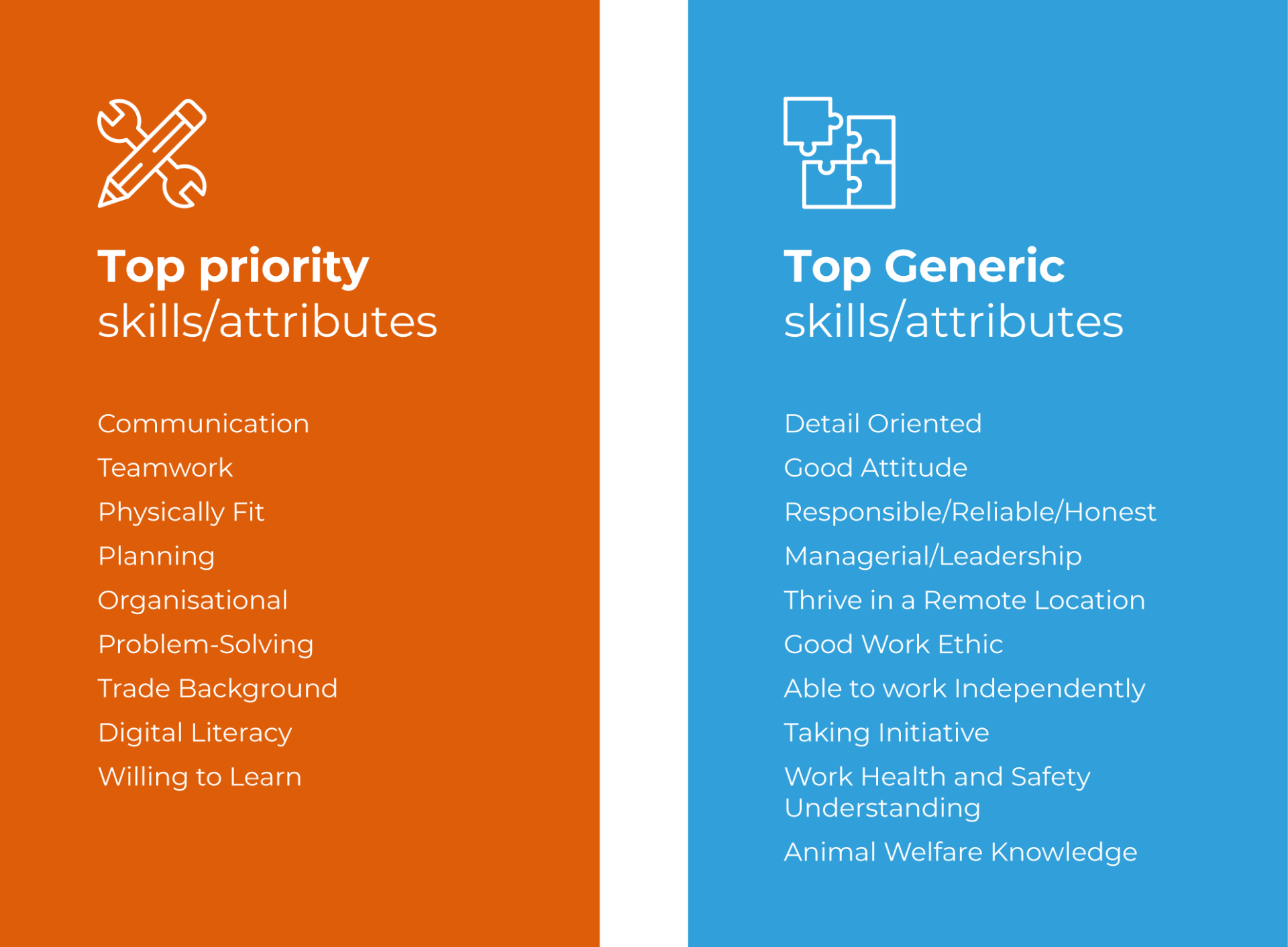
Source: ISACNT Field Survey, 2020
Looking to the future, there is an opportunity for Australian agricultural innovation to modernise and achieve greater and more diverse outcomes from investment in innovation, to adopt a more coordinated approach to respond to future opportunities, threats and trends and to better position Australia as a globally relevant agricultural innovation system.
Ernst and Young, 2019
Pathways

FARM WORKER
Beef Cattle Farm Workers (ANZSCO # 841511) perform routine tasks on a beef cattle farm such as feeding, mustering, and moving cattle and assisting with animal husbandry.
Mixed livestock farm workers (ANZSCO # 841513) perform routine tasks on a mixed livestock farm such as moving, feeding, and counting livestock, and assisting with animal husbandry.
Fruit or nut farm workers (ANZSCO # 841211) perform routine tasks on a fruit or nut farm such as cultivating and fertilising the soil and planting, irrigating, and pruning crops. They sometimes spray chemicals on crops to treat disease and pests.
Fruit or nut pickers (ANZSCO # 841212) harvest fruit and nuts and prepares produce for distribution.
Grain, oilseed or pasture farm workers (ANZSCO # 841213) perform routine tasks on grain, oilseed protein, or pasture farm such as cultivating and fertilising the soil and planting and irrigating crops. Some may spray chemicals on crops to treat disease and pests.
Vegetable farm workers (ANZSCO # 841214) perform routine tasks on a vegetable farm or market garden such as cultivating and fertilising the soil and planting and irrigating crops. Some may spray chemicals on crops to treat disease and pests.
Vegetable pickers (ANZSCO # 841215) harvest vegetables and prepares produce for distribution.
Skill Level: 5
Skills Sets
Organisation and coordination, Problem-solving, Active learning and listening, Machine maintenance and repairing, Operation control and monitoring, Time management skills, Critical thinking.
Certificate I in Agrifood Operations
Certificate II in Rural Operations
OR
Certificate II in Agriculture
Certificate III in Rural Operations
OR
Certificate III in Agriculture
Certificate IV in Agriculture
OR
Certificate IV in Agribusiness
Diploma of Agriculture
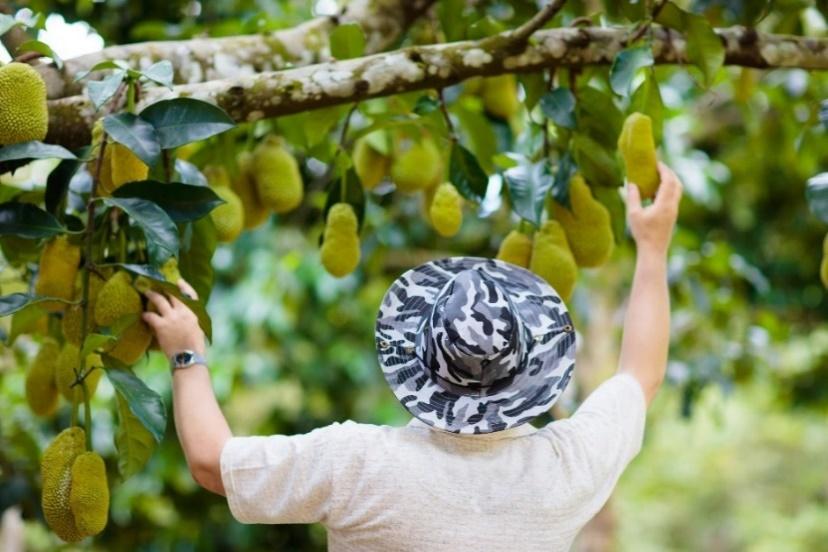
NURSERY PERSON
Nursery persons (ANZSCO # 362411) propagate and cultivate trees, shrubs, and ornamental and flowering plants in plant nurseries.
Skill Level: 3
Skills Sets
Organisation and coordination, Time management, Active learning and listening, Critical thinking, Problem-solving, Operation control and monitoring skills.
Certificate II in Horticulture
Certificate III in Horticulture
OR
Certificate III in Production/Retail Nursery
OR
Certificate III in Commercial Seed Processing
Certificate IV in Agriculture
OR
Certificate IV in Production Horticulture
Diploma of Agriculture
OR
Diploma of Production Nursery Management
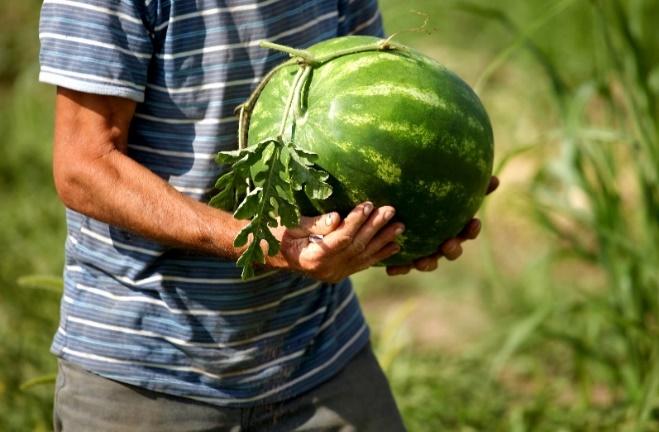
AGRICULTURAL AND HORTICULTURAL MOBILE PLANT OPERATOR
Agricultural and horticultural mobile plant operators (ANZSCO # 721111) operate agricultural and horticultural plant to clear and cultivate the land, sow, and harvest crops.
Skill Level: 5
Skills Sets
Operation control and monitoring, Personnel Management, Problem-solving, Time management, Machine maintenance and repairing, Active learning and listening skills.
Certificate II in Rural Operations
Certificate III in Rural Machinery Operations

FARMERS AND FARM MANAGER
Crop farmers (ANZSCO Unit Group 1212) plan, organise, control, coordinate and perform farming operations to grow crops.
Livestock farmers (ANZSCO Unit Group 1213) plan, organise, control, coordinate and perform farming operations to breed and raise livestock.
Mixed crop and livestock farmers (ANZSCO Unit Group 1214) plan, organise, control, coordinate and perform farming operations to both grow crops and to breed and raise livestock.
Skill Level: 1
Skills Sets
Problem-solving, Personnel Management, Critical thinking, Negotiation and persuasion, Judgement and decision-making, Operation control and monitoring, Literacy and numeracy, System analysis and evaluation skills, Time management.
Certificate II in Rural Operations
OR
Certificate II in Agriculture
Certificate III in Rural Operations
OR
Certificate III in Agriculture
Certificate IV in Agriculture
OR
Certificate IV in Agribusiness
Diploma of Agriculture
Advanced Diploma in Agribusiness Management
Bachelor of Agricultural Science
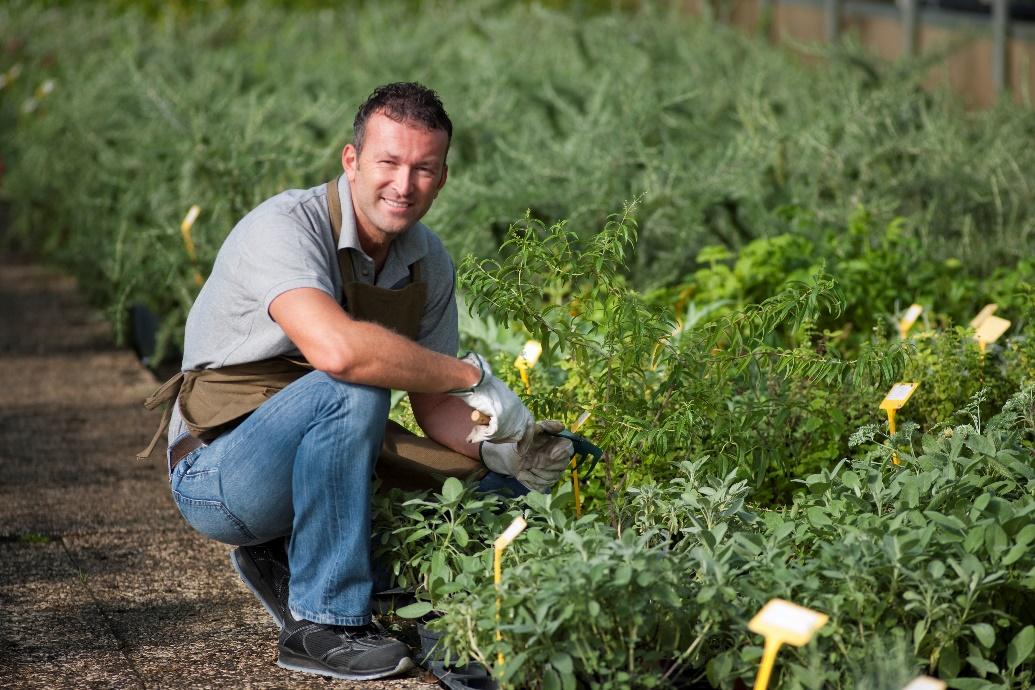
AGRICULTURAL TECHNICIAN
Agricultural technicians (ANZSCO # 311111) perform tests and experiments and provide technical support to assist Agricultural Scientists in areas such as research, production, servicing, and marketing.
Skill Level: 2
Skills Sets
Critical thinking, Judgement & decision-making, Problem-solving, Negotiation and persuasion, Literacy and numeracy, Engineering/Technological skills, Active learning & listening, Time management.
Diploma of Agriculture
Bachelor of Agricultural Science
AGRICULTURE ENGINEER
Agricultural engineers (ANZSCO # 233912) perform and supervise engineering work related to the use and development of agricultural land, buildings, machines, and equipment.
Skill Level: 1
Bachelor of Engineering (Agricultural)

AGRICULTURE CONSULTANT
Agricultural consultants (ANZSCO # 234111) advise farmers, agricultural businesses, rural industries and government on the production, processing and distribution of farm products.
Skill Level: 1
Bachelor of Agricultural Science
AGRICULTURAL SCIENTIST/AGRONOMIST
Agricultural scientists/Agronomists (ANZSCO # 234112) study commercial plants, animals, and cultivation techniques to enhance the productivity of farms and agricultural industries.
Skill Level: 1
Skills Sets
Literacy and numeracy, Critical thinking, Problem-solving, Active learning and listening, Judgement and decision-making, System analysis and evaluation, Time management, Organisation and coordination, Engineering/Technological skills.
Bachelor of Agricultural Science
Non-Traditional Agricultural Occupational Pathways
COOK
Cooks (ANZSCO # 351411) prepare, season and cook food in dining and catering establishments.
Skill Level: 3
Skills Sets
Coordination with others, Monitoring, Critical thinking, Active listening and learning, Time management, Operations control and monitoring, Judgement and decision making, Serving others, Quality control analysis skills.
Certificate III in Commercial Cookery
Certificate IV in Commercial Cookery
ELECTRICIAN (GENERAL)
Electricians (ANZSCO # 341111) installs, tests, connects, commissions, maintains, and modifies electrical equipment, wiring and control systems. Registration or licensing is required.
Skill Level: 3
Skills Sets
Troubleshooting, Installation, Critical thinking, Repairing, Coordination with others, Equipment Maintenance, Judgement and decision making, Operation control, Equipment selection, Active listening and learning skills.
Certificate III in Electrotechnology Electrician
Certificate IV in Electrotechnology - Systems Electrician
TRUCK DRIVER (GENERAL)
Truck drivers (ANZSCO # 733111) drive heavy trucks, removal vans, tankers and tow trucks to transport bulky goods and liquids. Registration or licensing is required.
Skill Level: 4
Skills Sets
Operations control and monitoring, Equipment Maintenance, Troubleshooting, Repairing, Time management, Coordination with others, Judgement and decision making, Critical thinking skills.
Certificate II in Driving Operations
Certificate III in Driving Operations
METAL FABRICATORS
Metal fabricators (ANZSCO # 322311) inspects, cut, shape, join and repair metal components of iron and steel structures, boilers, pressure vessels and pipes, ships and other vessels. Registration or licensing is required.
Skill Level: 3
Skills Sets
Operations control and monitoring, Equipment Maintenance, Troubleshooting, Repairing, Time management, Coordination with others, Judgement and decision making, Critical thinking skills.
Certificate III in Engineering - Fabrication Trade
DIESEL MOTOR MECHANIC
Diesel motor mechanics (ANZSCO # 321212) repairs maintain and test motor vehicle and other internal combustion engines and related mechanical components.
Skill Level: 3
Skills Sets
Repairing, Troubleshooting, Critical Thinking, Equipment Maintenance, Quality Control Analysis, Operation control and monitoring, Active learning and listening, Equipment Selection, Coordination with others, System evaluation skills.
Certificate III in Automotive Diesel Engine Technology
ACCOUNTANT
Accountants (ANZSCO # 221111) plan and provide accounting systems and services relating to taxation and the financial dealings of organisations and individuals and advise on associated record-keeping and compliance requirements.
Skill Level: 1
Skills Sets
Mathematics, System analysis and evaluation, Active learning and listening, Negotiation, Time management, Judgement and decision making, Coordination with others, Critical thinking skills.
Certificate III Accounts Administration
Certificate IV in Accounting and Bookkeeping
Diploma of Accounting
Advanced Diploma of Accounting
Bachelor of Accounting
Enrolments and Completions
Resources
http://www.governessaustralia.com/info/whatisagoverness.html
https://nteconomy.nt.gov.au/industry-analysis/agriculture,-foresty-and-fishing
https://www.agriculture.gov.au/abares/products/insights/snapshot-of-australian-agriculture-2020
https://www.pc.gov.au/research/completed/agriculture/agriculture.pdf
https://www.austrade.gov.au/agriculture40
https://economy.id.com.au/rda-northern-territory/value-add-by-industry
https://ntfarmers.org.au/wp-content/uploads/2018/11/2019HarvestReport_Final.pdf
https://ntfarmers.org.au/wp-content/uploads/2018/11/2018-Harvest-Labour-Report.pdf
https://ntfarmers.org.au/wp-content/uploads/2018/11/NT-2017-Harvest-Labour-Report-Final.pdf
https://industry.nt.gov.au/__data/assets/pdf_file/0004/948748/economic-overview-2018-2019.pdf
https://dpir.nt.gov.au/__data/assets/pdf_file/0005/443255/outlook-overview-2016.pdf
https://www.agriculture.gov.au/abares/research-topics/aboutmyregion/nt
https://nteconomy.nt.gov.au/industry-analysis/agriculture,-foresty-and-fishing
https://publications.csiro.au/rpr/download?pid=csiro:EP186191&dsid=DS3